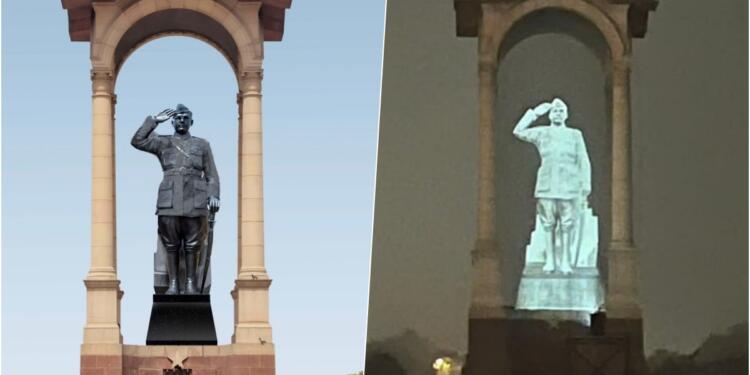In what comes as a proud, teary-eyed moment for every Indian, Prime Minister on Friday (January 21) announced that on the 125th birth anniversary of Netaji Subhash Chandra Bose, a grand statue made of granite will be installed at India Gate in his remembrance. The statue will be installed on the east side of India Gate under a canopy where George V’s statue once resided. Thus, more than symbolism, it is an attempt by the Modi government to reclaim history and simultaneously teach Congress a lesson for forgetting one of the true sons of the soil.
PM Modi took to Twitter to inform, “At a time when the entire nation is marking the 125th birth anniversary of Netaji Subhas Chandra Bose, I am glad to share that his grand statue, made of granite, will be installed at India Gate. This would be a symbol of India’s indebtedness to him.
https://twitter.com/narendramodi/status/1484421974629978113
PM Modi further added, “Till the grand statue of Netaji Bose is completed, a hologram statue of his would be present at the same place. I will unveil the hologram statue on 23rd January, Netaji’s birth anniversary,”
George V and the statue
The Coronation Park situated in northwest Delhi’s Burari area currently houses the marble-made grand statue of George V, which was erected first at India Gate when the Britishers held their third and last Delhi Durbar.
The Durbar of 1911 marked the succession of George V, who was crowned as the Emperor of India. Moreover, the capital of the country was shifted from Calcutta (now Kolkata) to Delhi.
Read More: ‘King’ George V’s statue in Delhi must be demolished and the ‘Coronation Park’ should be renamed
Congress diminished Netaji’s contribution
However, more than reclaiming the history from the imperialists, PM Modi’s move is supposed to set the Congress and Gandhi family in place. For more than six decades, the historical contribution of the non-Nehru-Gandhi families had been washed out to mainstream only one family.
The Modi government is now making efforts to revive the legacy of other leaders as well. After Sardar Patel, the government has focused its attention on Netaji Subhash Chandra Bose.
Subhash Chandra Bose was among the most important leaders of India’s independence movement, and some historians even go to the extent of crediting him more for independence than Gandhi but in the post-independence years, Congress systematically tried to erase him from public memory.
Subhash Chandra Bose made us flee: Clement Attlee
When British Prime Minister Clement Attlee who officially signed India’s independence document came to India in 1956, he was asked a seemingly simple question by Justice Chakraborty.
“You won world war II, you became a permanent member of UNSC, you handled the Quit India movement quite well then what made you leave India?” To which he replied, “Apart from the fact that India became a liability to us, the answer in three words is Subhash Chandra Bose and Indian National Army.”
Netaji, INA, Japan and the Red Fort trials
It was Subhash Chandra Bose that demanded Congress to not ask Indian soldiers to fight for the British in World War II. Instead, he wanted them to fight for the cause of India. That way, the Britishers, after losing the war would have been forced to flee back.
Bose believed that the second world war presented Indians with a great opportune moment to hit Britishers hard, as they were weak and vulnerable.
However, Congress, subservient as ever, had no such assertive plans. Instead, the party decided to urge Indian soldiers to fight for the British in both versions of the World War. They were hoping that in return for India’s loyalty, the British will grant them independence.
As a result, the Indian troops started fighting for the imperialists. However, this was the time Japan invaded South East Asia. Japan conducted a lightning campaign, annihilated the Britishers which culminated in the fall of the Malayan peninsula and Singapore in 1942. In the Singapore campaign alone, 45,000 Indian prisoners of war were captured.
It was then, Japan decided to create an auxiliary army that would fight the Britishers. 20,000 of them agreed to switch sides and go to war against their former masters — the British, in the Indian National Army under the command of Subhas Chandra Bose.
What Netaji was trying to do was to instigate rebellion in British Indian Armed Forces which eventually culminated in the Red Fort trials and the Royal Indian Navy Mutiny in February 1946, which became the instant reason behind the Britishers’ decision to leave India.
Resurrecting Netaji’s memory
However, the Congress government, and its historians, often reduce the mutiny of the Royal Indian Navy in just one paragraph and do not give Bose his due place in the history of the independence movement.
Bose was in the Congress party and held the Chair of the Congress President between January 1938 and April 1939 but due to internal bickering, he left Congress. Since then, the party and particularly the Gandhi family has gone to great lengths to reduce the significance of Bose’s contribution to the Indian independence struggle.
By installing the statue, the Modi government is resurrecting the memory of Netaji. The statue will also serve as a reminder to the Congress party that its attempts to cherish a single-family is no longer tolerable to the ordinary people of India.


































